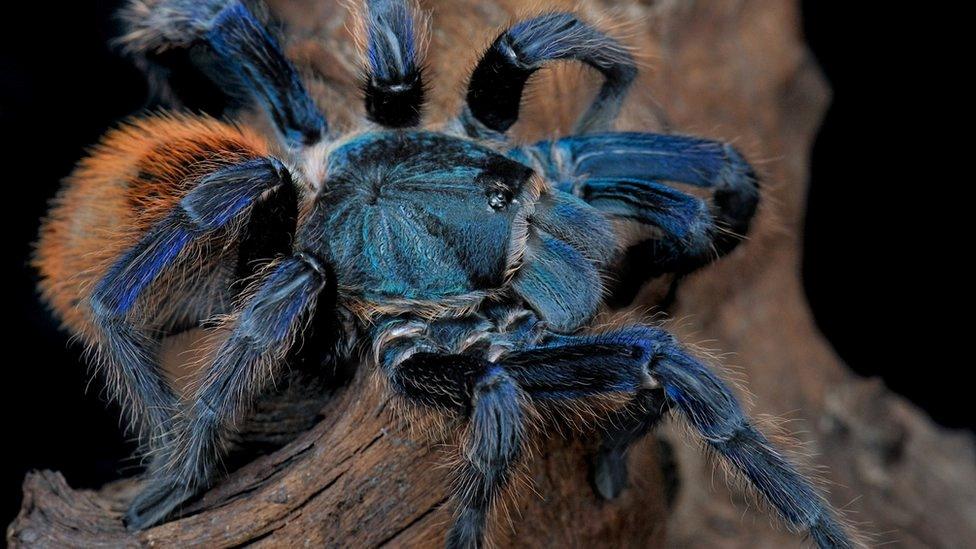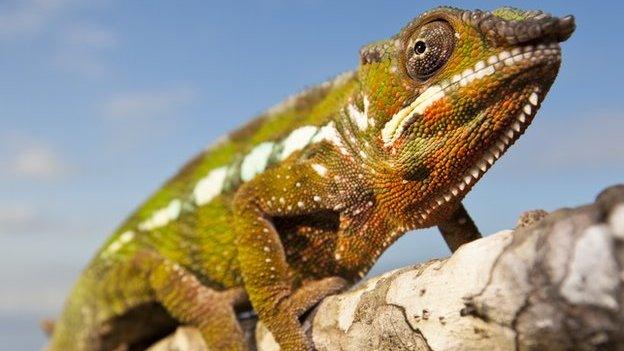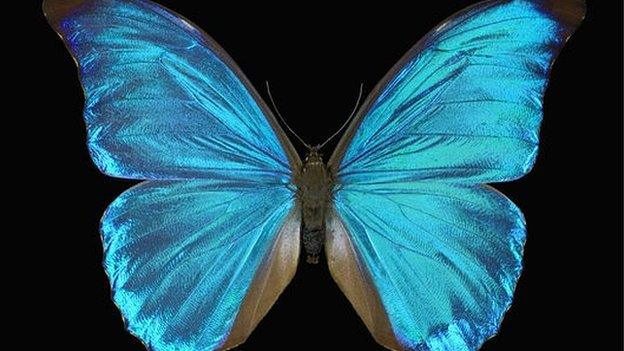Tarantulas evolved blue colour 'at least eight times'
- Published

If it's not for sex, why have so many tarantulas evolved this cobalt blue colour?
Tarantulas have evolved almost exactly the same shade of vibrant blue at least eight separate times.
That is the conclusion of a study by US biologists, exploring how the colour is created in different tarantula species.
The hue is caused by tiny structures inside the animals' hairs, but those shapes vary across the family tree.
This suggests, the researchers say, that the striking blue is not driven by sexual selection - unlike many other bright colours in the animal kingdom.
This argument is also supported by the fact that tarantulas have poor colour vision, and do not appear to show off their hairy blue body parts during courtship.
Blue branches
Nonetheless, Bor-Kai Hsiung and his colleagues found that 40 out of 53 groupings (genera) of tarantula exhibit a very vibrant blue.
"We collected published data and constructed a super-tree, which combined the previous published small trees," said Mr Hsiung, a PhD student at the University of Akron in Ohio and the first author of the study, published in Science Advances, external.
They then mapped blueness onto that evolutionary tree, based on a bank of tarantula snaps scoured from the internet.
"If the genus has at least one species that's blue, we say that's a blue genus," Mr Hsiung explained.
Given that scattering of blue species, he added, they then calculated "the lowest number of changes that can produce a distribution of blue colouring like this".
The answer? "Eight is the lowest number, so it's [evolved] at least eight times."

Soulful shade: A greenbottle tarantula is, oddly enough, bright blue
What is more, all these blue spiders evolved almost precisely the same shade; the wavelengths the team saw in the images all fell within a tight 20 nanometre range, clustered around 450nm - a bright, cobalt blue.
The team also purchased specimens of eight tarantula species, and took a close look at those blue hairs.
They used electron microscopes to zoom in on tiny shapes within the hairs and conducted simulations of how those shapes could produce a "structural colour" by reflecting - very specifically - this wavelength of blue light.
Receiver unknown
The results, again, pointed to the colour cropping up multiple times independently: several different types of shape could be seen, even on the same branch of the family tree.
"That's one of the reasons why it must have evolved so many times - because we don't see a very clear pattern of how these different mechanisms split," Mr Hsiung said.
"If we could see a clear split, then it might have evolved just one or two times. But it's all over the place."

Nanostructures in the spiders' hair produce the blue colour by reflecting specific wavelengths of light
So why did all these different species acquire the same colour?
Given their relatively simple eyes, it is doubtful that tarantulas can distinguish this shade of blue from any other colour.
That is one of the reasons that sexual selection seems unlikely - by contrast with some other spiders, which have remarkably good vision and put on very colourful courtship displays, such as the mesmerising peacock spider.
"It evolved from multiple origins and different mechanisms produce the very same blue colour," Mr Hsiung said. "That's very strong evidence to suggest that this blue colour has a very important visual signalling function.
"But if it's not for other tarantulas, then it must be to some other receivers out there."
It may be that this colour helps conceal the critters from their prey while they hunt at night; or perhaps it serves as a warning to stop the tarantulas themselves being eaten.
"We don't know yet," Mr Hsiung said.
Follow Jonathan on Twitter, external
- Published11 March 2015

- Published9 July 2014
